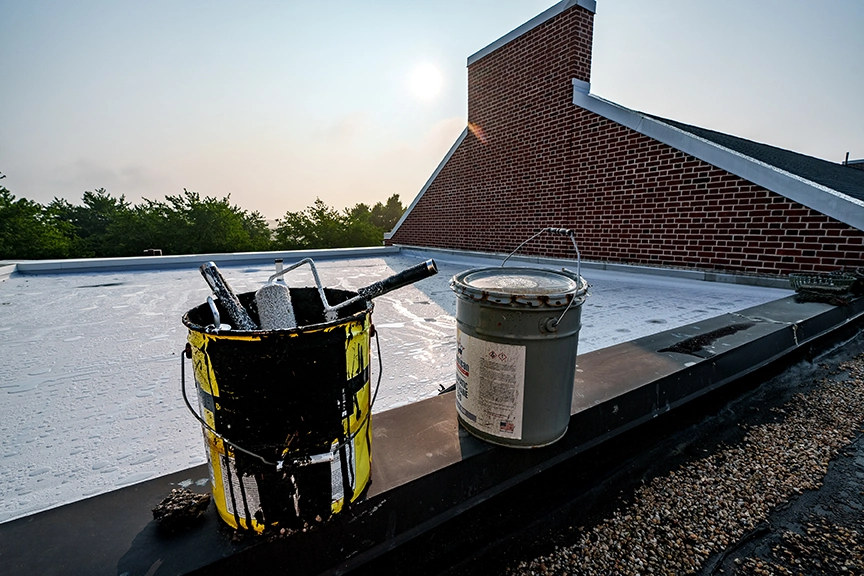Cool, Reflective Roofing Offers More Than a Comfortable Indoor Environment
No matter what part of the country you live in – the Northeast or the Southwest – temperatures can soar, and summers can be hot. If you are a commercial building owner, this is a serious concern, because you want to ensure the people and products within your facilities stay cool. Aside from planting trees around your commercial buildings, what can be done to ensure your building stays cool? A cool, reflective roof might be the answer.

A cool, reflective roof is a commercial cool roof system that is designed to reflect sunlight and absorb less heat, compared to a traditional roof. Similar to how wearing light colors on a sunny day can keep you comfortable, cool roofs use bright solar-reflective surfaces to maintain lower temperatures. Most commercial and industrial buildings benefit from cool roofs, but a building owner should consider the climate factors in their region before installing one.
A cool, reflective roof is created using reflective materials that have high solar reflectance and thermal emittance properties. The goal of this type of roof is to reduce the amount of solar radiation absorbed by the roof itself, thus lowering the surface temperature and making the building cooler. A standard dark roof can reach temperatures of 150 degrees Fahrenheit or more in the summer, while a bright, white, cool roof under the same conditions can stay 50 degrees cooler. “Coolness” is measured by two properties: solar reflectance and thermal emittance. Both properties are measured from 0 to 1, where 1 is 100% reflective or emissive. The higher the value, the cooler the roof.
Cool roofs can come in various forms, including:
Reflective Roof Coatings
By applying reflective coatings to an existing roof, facility owners can enhance their building’s solar reflectance. These coatings should be applied by a professional commercial roof coating company.
Cool Roofing Materials
By using roofing materials with inherent reflective properties, such as cool roof shingles, tiles, or metal roofing, facility managers can make their facilities more comfortable. Reach out to a licensed professional for a commercial roof assessment, who can recommend the best type of industrial roofs for your facility.
Vegetative Roofs
Green or vegetative roofs with living plants can also provide cooling benefits by offering both shade and the cooling effect of transpiration.
There are many advantages to installing a cool, reflective roofing system on your commercial building. This includes:
Less Energy Use
Because reflective roof materials absorb less heat, cool roofing systems diminish the amount of energy used to maintain the temperature within a building. This can reduce a commercial facility’s energy bills by 10 to 30 percent. Dark roofs absorb excess heat on the surface. This increases the temperature inside the building, which may result in occupants cranking up the air conditioning in an effort to be comfortable.
Increased Comfort
Not only does a cool roof save energy, but it also increases the comfort of those working inside the building. When the surface temperature of your roof increases, the air temperature inside increases as well.
If your building does not have an air conditioner or if your air conditioning system doesn’t properly cool the building, a cool roofing system could be the solution. By preventing the sun’s heat and UV rays from getting absorbed into the building, facility owners can ensure the building will be cooler.
Financial Savings
In addition to saving money on cooling costs, a cool roof can extend the life of a roofing system, so it doesn’t need to be replaced as often. That’s because excessive heat and UV rays can cause damage to a roofing system. By covering your roof with solar reflectance or other cool roofing materials, facility owners can save money by preventing roof repairs or premature replacement.
Environmentally Friendly
Installing a cool, reflective roof also benefits the environment. Using less cooling energy in your commercial building can lower emissions from power plants. Cool roofing systems can also curtail the urban heat island effect, which occurs in urban areas that have limited access to vegetation and open spaces. Because traditional roofing products absorb so much heat, areas with highly concentrated commercial buildings can be several degrees hotter than the surrounding areas. When commercial building owners install a cool roofing systems, the urban heat island effect can be prevented.
The other environmental benefits of cool, reflective roofing include reducing peak electricity demand, which can help prevent power outages, and alleviate air pollution and global warming concerns by lowering CO2 and other emissions.
Cool, Reflective Roof Considerations
While cool, reflective roof systems offer many benefits, it’s important for building owners to consider the climate in which their facility resides before selecting a system. Cool roofs achieve the greatest cooling savings in hot climates, and may not always decrease energy costs in cooler climates.
While cool roof owners may pay slightly more to heat their buildings during the winter, the amount is usually insignificant compared to the energy savings achieved during the summer. In warm, moist locations, cool roofs may be more susceptible to algae or mold growth than conventional roofing systems.
Conclusion
The benefits of a cool, reflective roof include energy and financial savings, increased occupant comfort and numerous environmental benefits. These types of roofing systems are also affordable. Many cool, reflective roofs cost the same as other roofing materials; and, for those that cost slightly more the difference can quickly be recovered in savings from lower energy costs.
If you think a cool, reflective roof would benefit your commercial building and its occupants, contact Capital Roof Care to schedule an appointment to determine the type of commercial roof that would be the best fit for your facility.